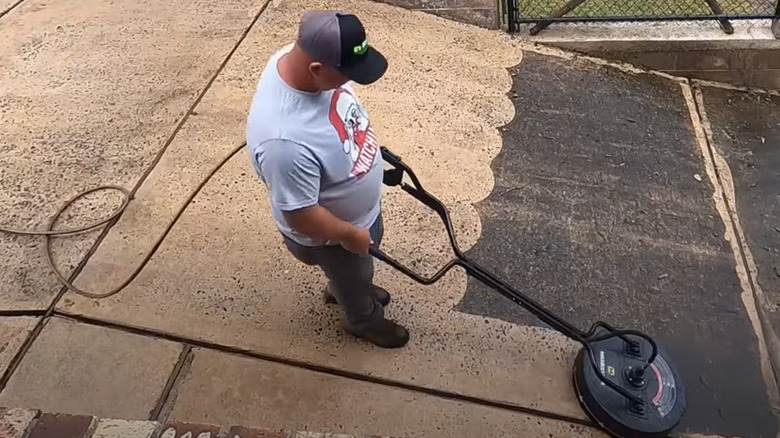The Scientific Reason Why 'Oddly Satisfying' Videos Are So Popular
For nearly 20 years now, the internet community has been a part of an experiment that, for all intents and purposes, has been a success by every measure. YouTube, which has been a thing since 2005, according to Britannica, has effectively given anyone with a video camera and an internet connection the ability to produce their own mass media. The result is that the platform hosts videos about anything and everything. Those who are interested in, say, vintage car restoration, will find that there's an entire subgenre devoted to that topic. There's also chess, fireworks, and even house cleaning.
One YouTube subgenre that has exploded in recent years is the "oddly satisfying" subgenre. Videos that fall under this category generally show a task being accomplished, such as power-washing a driveway (as in the screenshot above) or perhaps some application of geometry, such as a bar of soap being cut into squares.
The exact reason "oddly satisfying" videos are so, um, satisfying, has eluded science, according to Discover Magazine, although the answer almost certainly has something to do with the same reward system in the brain that, in extreme cases, manifests in obsessive-compulsive disorder (or OCD).
'Oddly Satisfying' Predates YouTube
Though YouTube is the go-to source for oddly satisfying videos, they're, in fact, everywhere where media can be hosted. As The New York Times notes, they're found on Instagram, as well, and they also abound on Facebook, but that's just as it relates to social media. In fact, the genre, in its online form at least, actually got started not on social media, but on a subreddit message board r/oddlysatisfying in 2013, according to The Guardian. The forum allowed, and allows, users to post photos and videos of situations that, for whatever reason, inform some sort of satisfaction in the viewer. As of June 2022, it has over 7.1 million subscribers.
A few years later, in 2016, the "oddly satisfying" video phenomenon exploded, according to The New York Times, for reasons that remain unclear, although writer Emily Matchar notes that it was in that same year that she found herself inexplicably drawn to the genre. "It was 2016 when I discovered Oddly Satisfying, and I needed a little brain massage ... Awake at 2 a.m., jiggling the baby, I'd tap open my phone, glance at the headlines and immediately hide it under my pillow. Oddly Satisfying was one of the few corners of the internet that didn't make me want to cry and never stop," she wrote.
The Connection To ASMR
The concept of "oddly satisfying" and ASMR are often discussed in the same breath – though they are not the same thing, they are related. For those not familiar, ASMR stands for "autonomous sensory meridian response," the scientific name given to a physical sensation of tingling, particularly one that starts at the intersection of the neck and shoulders, and tingles down the spine. ASMR can be triggered by such things as whispering, or clacking fingernails rhythmically onto a surface, or crinkling paper, or anything or nothing. Of course, the physiological mechanism probably predates the internet by hundreds of thousands of years, but now it's possible for people who experience ASMR to identify what triggers it and, ideally, watch a video that generates the desired response.
"Oddly satisfying" videos aren't necessarily the same thing, although there's doubtless some overlap. A video of a hand squishing slime, and in particular the audio of the event, for example, may produce a feeling of being satisfied in some users, and it may trigger ASMR in others. But at the same time, a video of someone power-washing a driveway may satisfy millions of users but trigger the ASMR event in only a few others (if any).
A Job Well Done?
As mentioned previously, the scientific community hasn't quite nailed down what it is about "oddly satisfying" videos that makes them so satisfying. Clearly, these types of videos activate the reward system in the brain, according to Discover Magazine, although the exact mechanism remains elusive. Author Nathaniel Scharping notes that videos depicting, say, a dirty driveway being power-washed, trigger a feeling of completion, the same feeling of satisfaction that a human gets from a job well done. "The oddly satisfying videos appear to tap into a subconscious urge toward what psychologists call a 'just right' feeling. It's the sensation that arises when we've put things in order," he writes. Further still, this feeling of completion eludes people with obsessive-compulsive disorder (OCD), whose brains somehow don't always register "completion" and resort to repetitive tasks in their quest for that reward.
Keen to explore this avenue of thinking, Spanish researchers did an experiment in which a control group and a group of people diagnosed with obsessive-compulsive disorder (OCD) were given a task and stopped in the middle of it. Surely enough, both groups were "uncomfortable," the OCD patients more so — a couple of whom completed the task on their own time and sent their completed projects to the researchers. This research seems to suggest (though doesn't conclusively prove) that there's some connection between the brain's reward system and the mechanism responsible for oddly satisfying videos.



